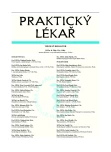-
Medical journals
- Career
Acellular porcine dermis in local treatment of diabetic food syndrome
Authors: M. Dubský 1; A. Jirkovská 1; R. Bém 1; B. Sixta 2; V. Fejfarová 1; L. Řezaninová 1; E. Matoušková 3; J. Skibová 4
Authors‘ workplace: Centrum diabetologie IKEM, Praha Přednostka: prof. MUDr. Terezie Pelikánová, DrSc. 1; Klinika transplantační chirurgie IKEM, Praha Přednosta: prof. MUDr. Miloš Adamec, CSc. 2; Klinika popáleninové medicíny, 3. LF UK a FNKV Přednosta: doc. MUDr. Leo Klein, CSc. 3; Oddělení statistiky IKEM 4
Published in: Prakt. Lék. 2010; 90(6): 342-348
Category: Of different specialties
Overview
Diabetic foot disease is one of the most common and most severe complications of diabetes. Aetiology of chronic ulcers is multifactorial and adequate therapy is often very difficult. Acellular porcine dermis could be used to treat chronic wounds with no signs of osteomyelitis and without critical ischaemia. The main advantages of acellular porcine dermis are its ability to be stored for long periods in dried form and its availability. In accordance with the results of our pilot study performed on 14 patients, the use of acellular porcine dermis in therapy of superficial non-infected ulcers was more efficient than with xenografts and is an appropriate alternative to modern bioengineered skin substitutes. We did not observe any serious adverse effects of this treatment.
Keywords:
diabetic foot, wound healing, skin substitutes, xenografts.
Sources
1. Armstrong, D.G., Lavery, L.A., Harkless, L.B. Validation of a diabetic wound classification system. The contribution of depth, infection, and ischemia to risk of amputation. Diabetes Care 1998, 21(5), p. 855-859.
2. Bello, Y.M., Falabella, A.F., Eaglstein, W.H. Tissue-engineered skin: current status in wound healing. Am. J. Clin. Dermatol. 2001, 2(5), p. 305-313.
3. Dini, V., Romanelli, M., Piaggesi, A. et al. Cutaneous tissue engineering and lower extremity wounds (part 2). Int. J. Low Extrem Wounds 2006, 5(1), p. 27-34.
4. Dubský, M., Jirkovská, A., Bém, R. et al. Use of allogenic dermoepidermal grafts can accelerate healing of diabetic foot disease (Abstract). EWMA Journal 2008, 8 (Suppl.), p. 59.
5. Eldor, R., Raz, I., Ben Yehuda, A. et al. New and experimental approaches to treatment of diabetic foot ulcers: a comprehensive review of emerging treatment strategies. Diabet. Med. 2004, 21(11), p. 1161-1173.
6. Gentzkow, G.D., Iwasaki, S.D., Hershon, K.S. et al. Use of Dermagraft, a cultured human dermis, to treat diabetic foot ulcers. Diabetes Care 1996, 19, p. 350–354.
7. Jirkovská, A. Syndrom diabetické nohy – základní informace, In: Syndrom diabetické nohy, Ed: Jirkovská A. Praha: Maxdorf, 2006, s. 22 – 35.
8. Marston, W.A., Hanft, J. Norwood, P. et al. The efficacy and safety of Dermagraft in improving the healing of chronic diabetic foot ulcers: results of a prospective randomized trial. Diabetes Care 2003, 26, p. 1701-1705.
9. Matoušková, E., Brož, L., Pokorná, E. et al. Prevention of burn wound conversion by allogeneic keratinocytes cultured on acellular xenodermis. Cell Tissue Bank 2002, 3(1), p. 29-35.
10. Mezinárodní pracovní skupina pro syndrom diabetické nohy. Syndrom diabetické nohy. Mezinárodní konsensus. Amsterdam, 1999. České vydání: Ed. Jirkovská A. Praha: Galén, 2000.
11. Mostow, E.N., Haraway, G.D., Dalsing, M. et al. Effectiveness of an extracellular matrix graft (OASIS Wound Matrix) in the treatment of chronic leg ulcers: a randomized clinical trial. J. Vasc. Surg. 2005, 41(5), p. 837-843.
12. Niezgoda, J.A., Van Gils, C.C., Frykberg, R.G. et al. Randomized clinical trial comparing OASIS Wound Matrix to Regranex Gel for diabetic ulcers. Adv. Skin Wound Care 2005, 18(5), p. 258-266.
13. Sixta, B., Herdegen, P., Bém, R. et al. Zkušenosti s xenotransplantáty při hojení diabetické nohy. Chirurgie HPB 2003, 11(1), s. 37-38.
14. Veves, A., Falanga, V., Armstrong, D.G. et al. Graftskin, a Human Skin Equivalent, Is Effective in the Management of Noninfected Neuropathic Diabetic Foot Ulcers. Diabetes Care 2001, 24, p. 290-295.
15. Winters, C.L., Brigido, S.A., Liden, B.A. et al. A multicenter study involving the use of a human acellular dermal regenerative tissue matrix for the treatment of diabetic lower extremity wounds. Adv. Skin Wound Care 2008, 21(8), p. 375-381.
16. Zajíček, R., Brož, L., Klein, L. a kol. Xe-Derma: nový biologický kryt pro léčbu akutních a chronických ran. Hojení ran 2008, 2(2), s. 18-27.
Labels
General practitioner for children and adolescents General practitioner for adults
Article was published inGeneral Practitioner

2010 Issue 6-
All articles in this issue
-
Evoluce a evoluční teorie pro lékaře
VI. Evo-devo
(evoluční vývojová biologie) - The etiology and new clinical-etiology-anatomy-pathophysiology (CEAP) classification of extremitovascular ischemic disease
- Acellular porcine dermis in local treatment of diabetic food syndrome
- Smoking and type 2 diabetes mellitus
- Foreign-born and homeless persons – new epidemiologic and social factors in the control of tuberculosis in Prague
- The gap between the objective and the subjective, patient stress, psychosomatics
- Gambling and the work environment
- Supervision as a method of prevention of burn-out syndrome in health care professionals
- Adverse effects of non-steroidal anti-inflammatory drugs
- Activation of processes of change in adolescent smokers
-
Evoluce a evoluční teorie pro lékaře
- General Practitioner
- Journal archive
- Current issue
- Online only
- About the journal
Most read in this issue- Adverse effects of non-steroidal anti-inflammatory drugs
- The gap between the objective and the subjective, patient stress, psychosomatics
- Supervision as a method of prevention of burn-out syndrome in health care professionals
- The etiology and new clinical-etiology-anatomy-pathophysiology (CEAP) classification of extremitovascular ischemic disease
Login#ADS_BOTTOM_SCRIPTS#Forgotten passwordEnter the email address that you registered with. We will send you instructions on how to set a new password.
- Career

